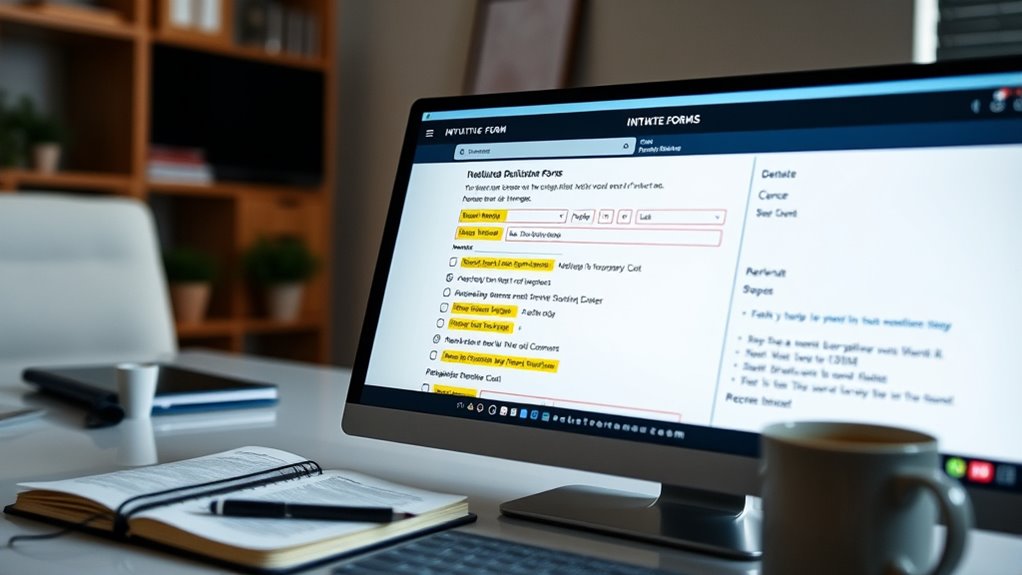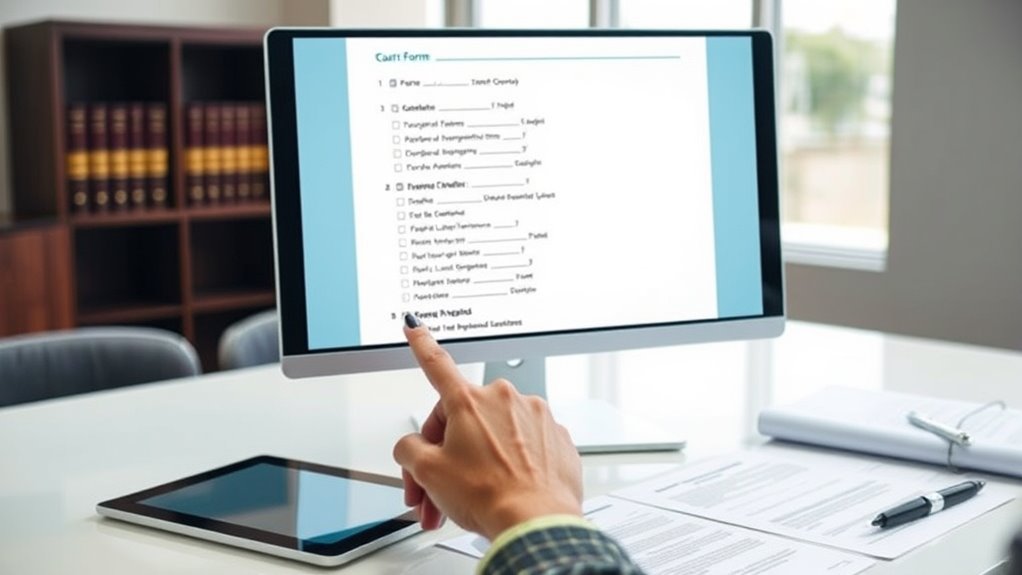Online forms for self-represented litigants provide accessible, guided tools to help you navigate family law procedures easily. Platforms like NPADO and I-CAN Legal automate document creation, offer step-by-step instructions, and simplify complex legal language. While they boost accuracy and reduce errors, some challenges remain, like understanding legal terminology or technical barriers. If you keep exploring, you’ll discover how courts are improving these tools and what future features may help you even more.
Key Takeaways
- Many courts and agencies offer online legal forms tailored for self-represented litigants to simplify case filing processes.
- Automated document platforms provide guided, step-by-step assistance to ensure accurate and compliant form completion.
- Digital resources include interactive guides, tutorials, and accessible interfaces to enhance understanding and usability.
- Accessibility features and plain-language explanations help users with disabilities or limited legal knowledge navigate online forms.
- Integration with court systems and mobile-friendly designs streamline submissions and improve overall access for self-represented users.
The Growing Role of Digital Resources in Family Law

Digital resources are increasingly transforming family law by making legal information and forms more accessible to self-represented litigants. You no longer have to navigate complex court procedures or sift through outdated paper forms; online platforms now offer user-friendly tools to guide you through the process. Automated systems like NPADO and I-CAN Legal help you create legal documents efficiently, saving time and reducing errors. These resources provide step-by-step instructions, making legal procedures less intimidating. As a result, more individuals can handle their cases without expensive legal representation. Courts are also expanding their digital support, including self-help centers and educational materials, to meet the rising demand. Additionally, understanding specific vetted forms ensures that submissions meet court standards and improve your case’s chances of success. The digital transformation of legal resources empowers you to participate more actively in your family law case, even if you’re not a legal expert. Incorporating user-friendly technology can further enhance your ability to navigate the legal process with confidence. Recognizing the importance of tuning options in vehicle customization can also inspire innovative approaches to problem-solving during legal proceedings. Moreover, the availability of accessible legal information online helps bridge the gap for those with limited legal knowledge.
Key Online Platforms Supporting Self-Representation

You can access a variety of online platforms that provide legal forms and document assembly tools to support self-represented litigants. These platforms simplify the process with user-friendly interfaces and automated systems, making legal procedures more manageable. By exploring these resources, you can find the tools you need to navigate family law cases effectively. Additionally, understanding the privacy and cookie usage policies of these platforms can help you make informed decisions about your data security. Being aware of the juice detox side effects can also guide you in maintaining your well-being while managing legal stresses. Incorporating knowledge about raw food diet safety can further assist you in making informed choices when dealing with complex information. With the rise of Nike Tech in sneaker culture 2024, staying updated on innovative trends can inspire confidence in your legal presentations and personal style.
Accessible Online Legal Forms
Accessible online legal forms play a crucial role in empowering self-represented litigants by providing straightforward, user-friendly platforms to navigate complex legal processes. These platforms, like I-CAN Legal and court websites, simplify document preparation through guided interfaces that require minimal legal knowledge. They often include step-by-step instructions, clear language, and templates tailored to specific case types, such as family law or small claims. Many platforms are free or low-cost, reducing financial barriers. They also improve efficiency by enabling users to complete and submit forms electronically, saving time and minimizing errors. By making legal forms more accessible and easier to understand, these tools help you better manage your case and ensure your documents meet court standards.
Automated Document Platforms
Automated document platforms like NPADO, I-CAN Legal, and A2J Author have revolutionized how self‑represented litigants prepare legal documents. These tools simplify complex legal procedures by guiding you step-by-step through filling out forms, reducing errors and confusion. They offer user-friendly interfaces designed for non-lawyers, making legal documentation more accessible. By automating document assembly, these platforms save you time and money, helping you avoid costly mistakes. Many platforms also provide tailored templates for specific case types, such as divorce or child custody, ensuring your documents meet court requirements. Proper organization tips for your documents can further enhance efficiency when using these platforms. Additionally, understanding how arcade games work can inspire innovative approaches to designing intuitive user interfaces for legal technology, making the process even more user-friendly. Incorporating emotional support strategies can help users manage stress and stay focused during the legal process. Recognizing the importance of user experience design can lead to more effective and accessible legal tech solutions for self‑represented litigants. Leveraging AI-powered virtual reality in legal training could further improve user engagement and comprehension. As a result, you gain greater confidence in managing your case without professional legal assistance. These platforms are essential resources, promoting efficiency and independence for self‑represented litigants steering the legal system.
Features and Benefits of Automated Document Systems

Automated document systems streamline the process of creating legal forms by guiding you through structured prompts and options, reducing the need for extensive legal knowledge. They simplify complex legal language into clear questions, helping you accurately complete forms. These systems often include built-in checks for errors or missing information, minimizing mistakes that could delay your case. They also offer step-by-step guidance, making the process less intimidating and more manageable. The benefits include saving time and reducing costs compared to hiring an attorney. Additionally, these systems improve consistency and accuracy across documents, increasing your confidence that your forms meet court requirements. Moreover, understanding the website functionality and cookie categories can help you navigate these systems more securely and with better awareness of your privacy options. This can also help you understand document accuracy, ensuring your legal paperwork is correctly completed the first time. Familiarity with best practices for digital security can further protect your sensitive information during online submissions. Being aware of trustworthy sources can help you verify the reliability of the legal forms provided. Overall, automated document systems empower you to prepare legal paperwork efficiently, with less stress and greater assurance of correctness.
Challenges Faced by Self-Represented Litigants Using Online Forms

You might find online forms confusing because legal terminology can be difficult to understand. Technical barriers, like poor internet access or complex interfaces, can also make completing these forms challenging. These issues can hinder your ability to navigate the legal process effectively. Additionally, unfamiliarity with vetted cat food options or related terminology may further complicate understanding the forms’ requirements.
Navigating Legal Terminology
Have you ever tried to fill out an online legal form and found yourself confused by unfamiliar legal terms? It’s a common challenge for self-represented litigants. Legal language can be dense, technical, and filled with jargon that’s hard to understand. When you encounter terms like “custody,” “alimony,” or “discovery,” it’s easy to feel lost and unsure how to respond correctly. Misunderstanding these terms can lead to mistakes in your filings, delays, or even losing your case. Online forms often lack plain-language explanations, making it harder to grasp what’s being asked. Without proper guidance, you might struggle to interpret legal concepts or decide how to answer questions accurately. This confusion adds stress and increases the risk of errors in your legal documents.
Technical Accessibility Barriers
Despite the convenience of online forms, many self-represented litigants face significant technical accessibility barriers that hinder their ability to complete legal documents accurately. You might struggle with orchestrating complex websites or understanding how to find the right forms. Some platforms have confusing layouts or require advanced computer skills, making it difficult to proceed without frustration. Limited internet access, outdated devices, or slow connections can also prevent you from using online tools effectively. Additionally, digital forms often lack clear instructions or accommodations for users with disabilities, such as visual impairments or limited mobility. These barriers can cause delays, errors, or abandonment of the process altogether, leaving you without the legal support you need. Overcoming these challenges requires simplifying interfaces and providing accessible, user-friendly resources.
How Courts Are Enhancing Digital Support Services

Courts are actively enhancing their digital support services to better assist self-represented litigants by leveraging innovative technology and user-friendly online platforms. They’re expanding access through online forms, interactive guides, and step-by-step instructions that simplify complex procedures. Many courts now offer virtual self-help centers, where litigants can get immediate guidance, ask questions, and access educational resources. Automated document assembly tools, like NPADO and I-CAN Legal, streamline form completion, reducing errors and saving time. Courts also develop accessible websites with clear orientation, easy-to-understand language, and multimedia resources to accommodate diverse users. Additionally, some courts organize online workshops and webinars to educate litigants about legal processes, ensuring they feel more confident navigating the system independently. These efforts aim to make legal support more accessible, efficient, and user-centric.
Future Trends in Online Legal Document Accessibility

As technology continues to advance, online legal document accessibility is poised for significant growth and innovation. You can expect more intuitive platforms that guide you step-by-step through complex legal processes, making forms easier to understand and complete. Artificial intelligence will likely play a bigger role, offering personalized assistance and real-time feedback to reduce errors. Additionally, integration with court systems will streamline filing procedures, decreasing delays and manual interventions. Mobile-friendly designs will ensure you access forms anytime, anywhere. Enhanced accessibility features will support users with disabilities, breaking down barriers. As these tools evolve, you’ll benefit from more affordable, efficient, and user-centered solutions, empowering you to navigate legal processes with greater confidence and independence.
Frequently Asked Questions
How Secure Are Online Forms in Protecting Personal and Legal Information?
Online forms generally have security measures like encryption and secure servers to protect your personal and legal information. However, their security isn’t foolproof; hackers or data breaches can still happen. You should always check for trusted platforms with clear privacy policies and secure connections (look for HTTPS). Avoid sharing sensitive info on unverified sites, and consider using strong, unique passwords to keep your data safer.
Can Online Forms Fully Replace Legal Advice From Licensed Attorneys?
Online forms can’t replace legal advice from licensed attorneys, no matter how advanced they seem. They might help you get through simple paperwork, but they won’t catch the nuances or complex legal issues that only a professional can identify. You risk making costly mistakes, missing important rights, or misinterpreting laws. For truly complex or sensitive cases, professional legal guidance is essential—you deserve more than just online templates.
What Should I Do if an Online Form Is Too Complicated to Complete?
If an online form feels too complicated, don’t force yourself to complete it alone. Seek help from the court’s self-help center or legal aid organizations—they can offer guidance and clarify confusing parts. Use available online tutorials or videos if offered. Remember, it’s okay to ask for assistance from a pro bono attorney or a trusted friend with legal experience. Taking these steps guarantees you accurately complete your form and avoid mistakes.
Are Online Legal Forms Accepted in All Courts Nationwide?
Online legal forms aren’t accepted in every court nationwide. Acceptance varies by jurisdiction and case type, so it’s crucial to check your specific court’s rules. Some courts may require you to submit paper forms or attend in-person hearings. Always verify with your court’s website or contact their clerk’s office to confirm whether online forms are accepted and if additional procedures are necessary. This ensures your filings are valid and properly processed.
How Can I Get Help if I Encounter Technical Issues With Online Forms?
If you face technical issues with online forms, start by checking the court’s website for troubleshooting guides or FAQs. Over 70% of courts now offer online support or contact options, so reach out to their technical support team directly. You can also visit self-help centers or call the court for assistance. Don’t hesitate to ask for help—courts are increasingly providing resources to guarantee you navigate online systems successfully.
Conclusion
As you navigate the digital courtroom, online forms become your guiding compass, illuminating the path through complex family law procedures. These tools symbolize your growing independence and access to justice, breaking down barriers that once seemed insurmountable. While challenges remain, ongoing innovations aim to empower you further. Embrace these digital resources as your steadfast allies—your lighthouse in the storm—ensuring you’re never alone in your pursuit of fair and equitable legal outcomes.








